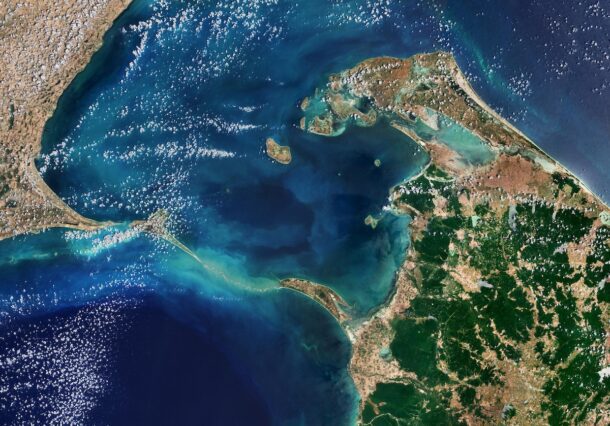 This Copernicus Sentinel-2 image shows Adam’s Bridge, a chain of shoals linking India and Sri Lanka.
This Copernicus Sentinel-2 image shows Adam’s Bridge, a chain of shoals linking India and Sri Lanka.
Adam’s Bridge, also known as Rama’s Bridge, or Rama Sethu, stretches 48 kilometers between Rameswaram Island, off the southeast coast of India, and Mannar Island, off the northwest coast of Sri Lanka. The bridge separates the Gulf of Mannar (south), an inlet of the Indian Ocean, from the Palk Strait (north), an inlet of the Bay of Bengal.
There are numerous theories about how the bridge was formed. However, geologic evidence suggests that these limestone shoals are the remnants of land that once connected India and Sri Lanka. According to records, this natural bridge was traversable until the 15th century, after which it was gradually eroded by storms over the years.
Some of the sandbanks are dry and, as the light color of the water indicates, the sea here is very shallow, only 1 to 10 meters deep.
Mannar Island covers about 130 square kilometers and is connected to mainland Sri Lanka by a road bridge and a railway bridge, both visible at the southern end of the island.
On the opposite side of Adam’s bridge, Rameswaram Island, also known as Pamban Island, can be accessed from the Indian mainland by the 2-kilometer-long Pamban Bridge. The two main towns on the island are Pamban, on the western edge, and Rameswaram, around 10 kilometers east of Pamban.
Both sections of Adam’s Bridge are part of protected national parks in their respective countries. The sand dunes serve as breeding grounds for birds such as the brown noddy, while numerous species of fish and sea grasses thrive in the shallow waters. Sea life around Adam’s Bridge includes dolphins, dugongs and turtles.
Image Credit: Contains modified Copernicus Sentinel data (2024), processed by ESA

